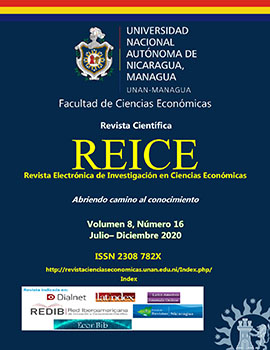Modelización organizativa y tecnológica del redespliegue de instalaciones industriales
DOI:
https://doi.org/10.5377/reice.v8i16.10664Palabras clave:
Redistribución de instalaciones industriales, Justificación de la renovación científica y técnica, Redistribución de áreas industriales, Despliegue urbano, Control de obraResumen
La redistribución de instalaciones industriales permite a las empresas optimizar su estructura y, al mismo tiempo, crear un entorno competitivo en el sector de servicios. Además, durante el proceso de redespliegue, el complejo inmobiliario se optimiza. Debido a la liberación de la producción, los costos podrían reducirse conservando, vendiendo y alquilando el espacio de producción. Sin embargo, para lograr y fortalecer la competitividad a largo plazo, las empresas se ven obligadas a ajustar sus actividades con énfasis en las cambiantes demandas del período. Dado que el mundo cambia constantemente, es muy importante responder a estos cambios de manera oportuna y rápida. Hasta ahora, la práctica internacional y la experiencia del redespliegue en la Federación de Rusia han demostrado que es una de las tareas de gestión más difíciles. Durante este proceso, se deben considerar muchas restricciones y características únicas de la empresa, donde se implementan. En consecuencia, debe llevarse a cabo solo en presencia de metas claramente definidas, el concepto de redistribución y una comprensión de cada etapa y los métodos que deben observarse. Este es un estudio relevante porque el modelo de trabajo realizado durante el redespliegue permite que este proceso se desarrolle de la manera más fluida y eficiente posible permitiendo a la empresa adaptarse a las nuevas condiciones del mercado. Sin embargo, el tema del estudio está poco cubierto en la actualidad. De hecho, muchas fuentes consideran una estrategia de rediseño solo como un estudio de caso especial de una estrategia de reestructuración o una estrategia para actualizar los activos fijos. Por lo tanto, se debe mejorar la documentación reglamentaria para los proyectos de construcción de capital y las instalaciones de redespliegue
Descargas
622
Citas
Abramov, I. (2019). Formation of integrated structural units using the systematic and integrated method when implementing high-rise construction projects. HRC 2017 (HIGH-RISE CONSTRUCTION-2017) E3S Web of Conferences, 2018, 33, 1-7.
Abramov, I., Poznakhirko, T., Sergeev, A. (2016). The analysis of the functionality of modern systems, methods and scheduling tools. MATEC Web Conf, 86, 1-5.
Ginzburg, A. (2016). Sustainable building life cycle design. MATEC Web of Conferences. XV International conference «Topical problems of architecture, civil engineering, energy efficiency and ecology», 02018.
Graham, P. (2003). Building Ecology: First Principles For A Sustainable Built Environment. Blackwell Science, 76.
Lapidus, A. (2014). Integral potential effectiveness of organizational and technological and managerial decisions of building object. Applied Mechanics and Materials, 584-586, 2230-2232.
Lapidus, A., Abramov, I. (2018). Formation of production structural units within a construction company using the systemic integrated method when implementing high-rise development projects. E3S Web of Conferences, 33.
Lapidus, A., Topchiy, D. (2019). Formation of Methods for Assessing the Effectiveness of Industrial Areas’ Renovation Projects. Proceedings of the IOP Conference Series: Materials Science and Engineering, 471, 1-6.
Lapidus, A.A., Govorukha, P.A. (2015). Organizational and technologic potential of setting of enclosing structures for residential buildings. International Journal of Applied Engineering Research, 10(20), 40946-40949.
Meneyluk, A.I., Lobakova, L.V. (2016). Methodology for choosing effective models for the implementation of buildings reprofiling projects. Bulletin of the Kharkov National Technical University. Series: Management Strategy, Portfolio Management, Programs and Projects, 1, 76-81.
Newton, S. (2016). The Being of Construction Management Expertise. Construction Management and Economics, 34, 7–8.
Oleynik, P., Sinenko, S., Zhadanovsky, B., Brodsky, V., Kuzhin, M. (2016). Construction of a complex object. MATEC Web of Conferences. 5th International Scientific Conference «Integration, Partnership and Innovation in Construction Science and Education», 4059.
Pezeshki, Z., Ivari, S.A.S. (2018). Applications of BIM: A Brief Review and Future Outline. Archives of Computational Methods in Engineering, 25(2), 273–312.
Pukhkal, V.A., Mottaeva, A.B. (2018). FEM modeling of external walls made of autoclaved aerated concrete blocks. Magazine of Civil Engineering, 81(5), 203-212.
Roodman, D.M., Lenssen, N.K., Peterson, J.A. (1991). A Building Revolution: How Ecology and Health Concerns Are Transforming Construction. Worldwatchlnst, 67.
Shinri, S., Masamichi, T. (n.d.). Developing environmental load factors for construction materials used in social infrastructure LCA. Enviromental System Research Papers, 38, 185-191.
Surya, B., Saleh, H., Syafri, Ahmad, D.N.A. (2019). Impact and Sustainability of New Urban Area Development in Moncongloe-Pattalassang, Mamminasata Metropolitan. Journal of Southwest Jiaotong University, 54(6). http://jsju.org/index.php/journal/article/view/462
Topchiy, D., Yurgaitis, A., Kravchuk, A., Shevchuk, D. (2019). Controlling methods of buildings' energy performance characteristics. Topical Problems of Architecture, Civil Engineering and Environmental Economics (TPACEE 2018) electronic edition. E3S Web of Conferences.
Volkov, A., Chulkov, V., Kazaryan, R., Fachratov, M., Kyzina, O., Gazaryan, R. (2014). Components and guidance for constructional rearrangement of buildings and structures within reorganization cycles. Applied Mechanics and Materials, 2281-2284.
Volkov, A., Sedova, A., Chelyshkov, P., Titarenko, B., Malyha, G., Krylov, E. (2016). The theory of probabilities methods in the scenario simulation of buildings and construction operation. Research Journal of Pharmaceutical, Biological and Chemical Sciences, 7(3), 2416-2420.
Zhadanovsky, B.V., Sinenko, S.A. (2014). Visualization of design, organization of construction and technological solutions. Computing in Civil and Building Engineering. Proceedings 2014 International Conference, 137-142.
Zueva, D.D., Babushkin, E.S., Topchiy, D.V., Yurgaitis, A.Yu. (2019). Construction supervision during capital construction, reconstruction and re-profiling. MATEC Web of Conferences, 265, 1-8.
Descargas
Publicado
Cómo citar
Número
Sección
Licencia
Copyright (c) Revista Electronica de Investigacion en Ciencias Economicas
Los derechos sobre los artículos publicados en REICE son de la revista, a los efectos de poder gestionar su mejor difusión. No obstante, puesto que la finalidad de la misma es la difusión del conocimiento, esta revista provee acceso libre inmediato a su contenido, bajo el principio de que hacer disponible gratuitamente la investigación al público, lo cual fomenta un mayor intercambio de conocimiento global.
Las opiniones expresadas por los autores no necesariamente reflejan la postura de la editora de la publicación ni de la UNAN-Managua Se autoriza su reproducción y distribución (en cualquier tipo de soporte) siempre que se cumpla las siguientes indicaciones:
- La autoría del trabajo
- Que se indique su origen (revista REICE, volumen, número y dirección electrónica del documento)

